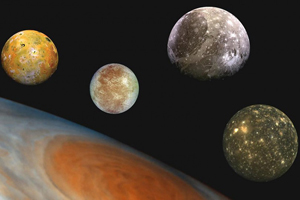
Io is the closest moon to Jupiter and one of the largest of its moons. It is also the most volcanic object in our solar system, with hundreds of active volcanoes and a constantly changing surface. Scientists believe that Io's intense volcanic activity is due to tidal heating caused by the strong gravitational pull of Jupiter and the other Galilean moons.

Europa is another one of Jupiter's Galilean moons and is considered to be one of the most likely places in our solar system to host extraterrestrial life. It has a smooth, icy surface that hides a vast ocean of liquid water beneath. Scientists believe that the ocean is kept warm by tidal heating, which may provide the necessary conditions for life to exist.
Ganymede is the largest moon in our solar system and is also one of Jupiter's Galilean moons. It is larger than the planet Mercury and is the only moon in our solar system known to have its own magnetic field. Ganymede is also thought to have a subsurface ocean of liquid water and could have the potential to host life.
 Callisto is the outermost of the Galilean moons and is one of the largest objects in the Jovian system. It has a heavily cratered and ancient surface that is thought to be one of the oldest in the solar system. Callisto is also believed to have a subsurface ocean, but it is less likely to host life due to its low levels of tidal heating.
Callisto is the outermost of the Galilean moons and is one of the largest objects in the Jovian system. It has a heavily cratered and ancient surface that is thought to be one of the oldest in the solar system. Callisto is also believed to have a subsurface ocean, but it is less likely to host life due to its low levels of tidal heating.
Themo is one of Jupiter's smallest moons and was discovered in 2000. It is one of the many small, irregularly shaped moons that orbit Jupiter and is thought to be a captured asteroid. Themo is interesting because it has a highly inclined orbit and is one of the few objects in our solar system with a retrograde rotation, meaning it rotates in the opposite direction of its orbit.
Amalthea is another one of Jupiter's small moons and is shaped like a potato. It is one of the innermost moons of Jupiter and is thought to be a captured asteroid. Amalthea is also the source of much of the dust in Jupiter's ring system, which makes it an important object for studying the Jovian system.
Metis is one of the smaller moons of Jupiter and is located in the inner part of the Jovian system. It was discovered in 1980 and is believed to be a captured asteroid. Metis is interesting because it is thought to be the source of a small dust ring that surrounds Jupiter.
Lysithea is one of the smallest moons of Jupiter and was discovered in 2000. It is one of the many small, irregularly shaped moons that orbit Jupiter and is thought to be a captured asteroid. Lysithea is also notable for its highly inclined and eccentric orbit, which makes it one of the more unusual objects in the Jovian system.
Janus and Epimetheus are two of Jupiter's smaller moons and were discovered in 1966. They are interesting because they share the same orbit and regularly swap places every four years. This is thought to be due to a gravitational interaction between the two moons, and is a unique phenomenon in our solar system.

These are just a few of the many moons of Jupiter, each with its own unique characteristics and stories to tell. Whether it's the intense volcanic activity on Io, the potential for extraterrestrial life on Europa, or the unusual orbits of Themo and Lysit - of these moons, it's clear that Jupiter's collection of moons is a rich and diverse one. From the largest moon in our solar system to the smallest, irregularly shaped captured asteroids, each of these moons holds its own secrets and has its own role to play in the larger Jovian system.
Despite the numerous advances in our understanding of these moons, there is still much we don't know. For example, the subsurface oceans of Europa, Ganymede, and Callisto are still largely a mystery and could hold many more discoveries in the future. And with new missions and technologies, we may be able to uncover even more about these fascinating objects in the coming years.
In conclusion, the moons of Jupiter are a testament to the diversity and complexity of our solar system. From their unique formations and origins to their varied surfaces and potential for life, each of these moons has a story to tell and continues to be a source of fascination and inspiration for scientists and space enthusiasts alike. With the constant advancements in technology and space exploration, the possibilities for discovery are endless. So, let's keep exploring and learning about these incredible moons and the many secrets they hold.











